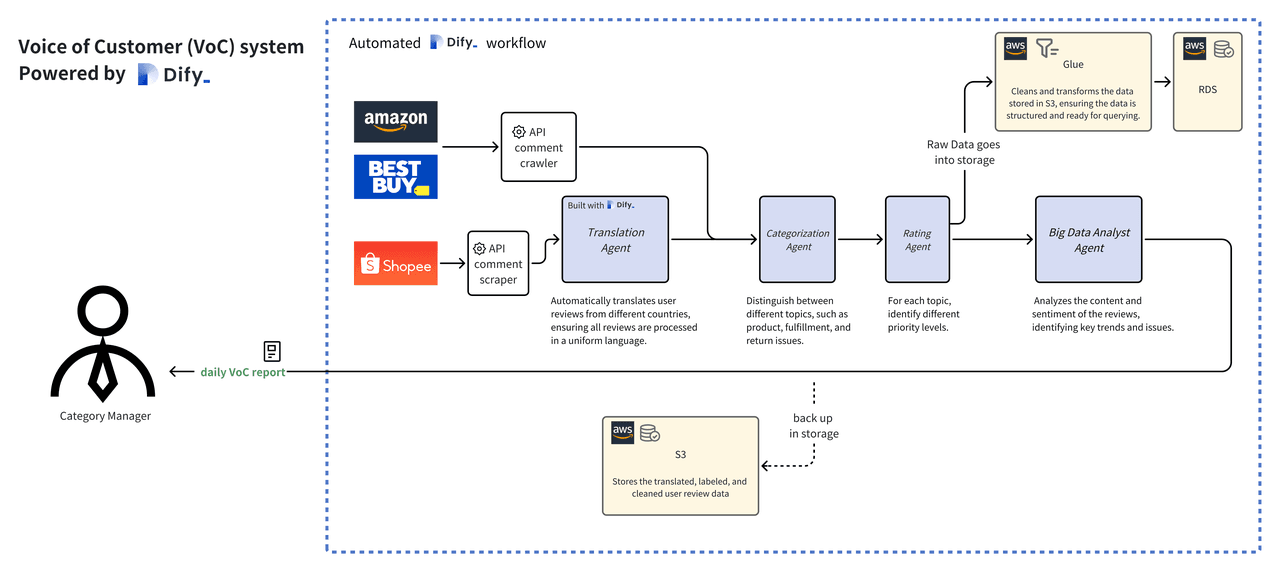Company
How Dify.AI powers the company that's powering the world
Aug 1, 2023
·
Oct 29, 2024
A global leader in consumer electronics, renowned for reshaping how people charge and interact with smart devices, supports over 100 million users worldwide through its extensive product lineup. To maintain its competitive edge, the company is leveraging Dify.AI to seamlessly integrate generative AI (genAI) into its operations, recognizing the transformative potential of this technology.
Bridging the Gap Between Business and Technology
The company faced a significant challenge in AI integration, often described as a divide between the “Left Wall” and the “Right Wall.” The “Left Wall” encompasses business scenarios where non-technical staff identify operational pain points and seek genAI-driven solutions but lack the technical skills to develop them. Meanwhile, the “Right Wall” represents the technical domain, where AI specialists possess a deep understanding of genAI’s capabilities but struggle to promptly identify the right tools due to limited insight into the business’s needs. This disconnect made each collaboration a time-consuming and resource-intensive process.
Dify.AI functions as a pivotal tool that bridges this divide, simplifying AI application development, facilitating effective cross-functional collaboration, and significantly enhancing productivity across the organization.
AI-Enhanced Operational Efficiency
“The first time I saw a non-technical colleague build a complex marketing workflow on Dify.AI, my jaw dropped.”recalled the Head of AI Platform & Services.
The company’s AI integration is comprehensive, involving every employee, and starts from the ground up. Employees are classified into three categories:
Novice Users: This group includes new hires, recent graduates, and even top executives who have minimal exposure to AI. Through Dify.AI’s low-code platform, they gain access to mainstream models and over a hundred simple AI applications, enabling them to start using AI tools right away. “New graduates on my team, after just one month, are already well-versed in the differences between models and can even advise senior business staff on whether to use Claude 3 or GPT-4 for a given task,” the Head of AI Platform & Services noted. To support these users, the company offers a large language model (LLM) application marketplace featuring models from the GPT and Claude series and collaborates with model providers for on-site demonstrations. These applications are specifically designed for novice users, allowing them to directly explore and engage with large language models.
Expert Users: This group consists of product managers and MarTech specialists who frequently utilize tools like ChatGPT. With Dify.AI, they can create customized solutions independently, without relying on technical teams. For example, many now prefer Dify.AI for multi-language translation because it allows for personalized adjustments. “Dify.AI enables product managers to build a multi-language translation agent that adapts content to the right tone and sentence structure for their specific use cases,” explained the Head. Expert users have developed innovative applications within Dify.AI’s LLMOps framework, driving productivity for both individuals and teams.
Developers: Developers make up the largest segment within the company. Previously, they had to frequently “reinvent the wheel” for routine tasks like setting up LangChain knowledge bases and registering APIs. “I often hear business staff say, ‘I don’t understand the technology; find someone to work on the large language model.’ Yet, the developers they find often lack expertise in LLMs too—it’s a common challenge,” said the Head. Dify.AI addresses these issues by consolidating the latest AI technologies—from inference endpoints to retrieval pipelines—into a single, visual interface. “We’ve registered all our large language model toolchains on Dify.AI and implemented componentized, low-code workflows, significantly enhancing our engineers’ efficiency,” the Head added.
"This developer no longer needed a product manager to provide a solution and could solve problems on his own."
— the Head of AI Platform & Services
One example of Dify.AI’s impact involves a developer who had no prior experience with LLM application development. After attending a tech conference where Dify.AI was demonstrated, he returned to his demanding workload, which involved system tuning, troubleshooting, and late-night coding. Using Dify.AI, he designed and developed a support chatbot in just two days, without needing assistance from a product manager to define the user story, design the chatbot, or schedule the implementation. “This developer is now highly motivated, registering frequently used system search queries and optimizing growth tools within the platform,” the Head shared.
Driving Real-world Impact
In just a month-long trial, Dify.AI has enabled the creation of over 200 AI applications within the company, with more than 60 actively in use. The most popular application has been utilized nearly 10,000 times, demonstrating the platform’s immediate value.
Dify.AI’s impact is particularly evident in the company’s Voice of Customer (VoC) system. Previously, product managers manually crawled and analyzed vast amounts of user reviews for smart devices across numerous countries. This process is now automated through Dify.AI-powered applications, allowing product managers to focus on enhancing the product’s Net Promoter Score (NPS)—a key metric for measuring user satisfaction.
The company now orchestrates various AI agents with specialized roles, such as translation experts, labeling engineers, big data analysts, and QA engineers, within complex Dify.AI workflows. These workflows, in conjunction with crawling tools, clean, analyze, and categorize user reviews, significantly reducing manual effort. “Our product managers no longer need to spend excessive time on this task and can now dedicate more energy to improving the NPS,” the Head of AI Platform & Services highlighted.
“With Dify.AI, we can break down the user journey into more granular sub-tasks and identify optimal experiences for analysis,” the Head explained. “For example, receiving a package is a user journey, where the task is to open the package, and the ideal experience would be that the packaging is intact, refined, and undamaged.”

Previously a manual process, this entire workflow is now automated through applications built on Dify.AI. “The Dify.AI workflows allow us to collect data more accurately and at a larger scale, leading to deeper customer insights,” the Head added.
Toward True AI Democratization
“AI has already become a core competitive advantage of our company, and this is just the beginning,”the Head of AI Platform & Services
The company’s successful AI integration illustrates the power of a bottom-up approach, empowering employees at all levels—from non-technical staff to developers—to leverage AI for enhancing their work. This shift is also shaping the company’s talent recruitment strategy, which now prioritizes potential over specific skill sets, seeking out creative thinkers with strong practical abilities. “In the AI field, development capabilities vary greatly. As long as someone shows these traits, we don’t need to worry about their specific tech stack or past engineering experience; they can still achieve great results,” the Head noted.
Looking forward, the company aims to continue boosting operational efficiency by further expanding the use of AI. “Intelligence has become a key competitive edge for us, and this is just the beginning,” the Head concluded.



